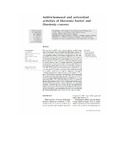| dc.contributor.author | Omisore, N.O.A. | |
| dc.contributor.author | Adewunmi, C.O. | |
| dc.contributor.author | Iwalewa, E.O. | |
| dc.contributor.author | Ngadjui, B.T. | |
| dc.contributor.author | Adenowo, T.K. | |
| dc.contributor.author | Abegaz, B.M. | |
| dc.contributor.author | Ojewole, J.A. | |
| dc.contributor.author | Watchueng, J. | |
| dc.date.accessioned | 2009-02-13T13:00:13Z | |
| dc.date.available | 2009-02-13T13:00:13Z | |
| dc.date.issued | 2005 | |
| dc.identifier.citation | Omisore, N.O.A. et al (2005), Antitrichomonal and antioxidant activities of Dorstenia barteri and Dorstenia convexa, Brazilian Journal of Medical and Biological Research, vol. 38, no. 7, pp. 1087-1094 | en |
| dc.identifier.issn | 0100-879X | |
| dc.identifier.uri | http://hdl.handle.net/10311/284 | |
| dc.description.abstract | Dorstenia barteri and D. convexa extracts and some isolated components
of the former were investigated for effectiveness against Trichomonas
gallinarum and compared with quercetin and quercitrin.
The antioxidant activity of the extracts/compounds was also determined.
The minimum lethal concentrations (MLCs) for the extract of
D. barteri leaves and twigs at 24 h were found to be 15.625 and 15.625
μg/ml, respectively. However, the MLCs of the leaf and twig extract of
D. convexa were 125 and 437.5 μg/ml, respectively. The prenylated
and geranylated chalcones were as active as the prenylated flavones, 6-
prenylapigenin and the diprenylated derivative 6,8-diprenyleridictyol.
The order of the antitrichomonal activity of the compounds at 24 h
was: quercetin (0.121 μg/ml) > quercitrin (0.244 μg/ml) ≥ bartericin B
(0.244 μg/ml) > bartericin A (0.73 μg/ml) > stigmasterol (0.98 μg/ml)
> 6,8-diprenyleridictyol = isobavachalcone = dorsmanin F (31.25 μg/
ml). D. barteri extracts, quercitrin, and bartericin A, and the prenylated
flavonoids had potent antioxidant properties. The twig extract of D.
barteri was more potent than the leaf extract. Moderate (EC50 >50 μg/
ml) and high (EC50 <50 μg/ml) antioxidant activities were detected in
the leaf and twig extracts of D. barteri and the prenylated flavonoids.
Prenylated flavonoids and the isolated compounds with antioxidant
properties described here may account for the anti-inflammatory
action of these extracts. The antitrichomonal and antioxidant activities
shown by the extracts and compounds in this study are consistent with
the ethnomedicinal and local use of the Dorstenia species studied. | en |
| dc.language.iso | en | en |
| dc.publisher | Brazilian Journal of Medical and Biological Research. http://www.scielo.br/scielo.php?pid=0100-879X&script=sci_serial | en |
| dc.subject | Dorstenia species | en |
| dc.subject | Antitrichomonal | en |
| dc.subject | Antioxidant activity | en |
| dc.subject | Prenylated flavonoids | en |
| dc.title | Antitrichomonal and antioxidant activities of Dorstenia barteri and Dorstenia convexa | en |
| dc.type | Published Article | en |

